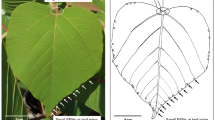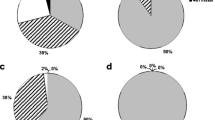Abstract
Utilization of the extrafloral nectaries (EFNs) and fruits of Canavalia lineata and C. cathartica by ants was investigated at 30 sites in Japan. The fruits of C. lineata and C. cathartica were inhabited by five and eight ant species, respectively. Ant nesting periods and their utilization of EFNs differed between C. lineata and C. cathartica. Canavalia lineata flowers once a year, and periods of EFN-utilization and fruit-nesting by ants do not overlap. The fruit-nesting ants on C. lineata seem to invade the plant from the holes made by moth larvae or breaches made by decay. The ants nesting on the fruits of C. lineata may defend the plant against seed herbivores because they feed on moth larvae. Canavalia cathartica flowers several times over a year, and fruits are found throughout the year; therefore, periods of EFN-utilization and fruit-nesting by ants are overlapped. Canavalia cathartica offers year-round nesting sites and food for ants, and therefore may receive a higher defensive effect from ants than C. lineata.



Similar content being viewed by others
References
Apple JL, Feener DH Jr (2001) Ant visitation of extrafloral nectaries of Passiflora: the effects of nectary attributes and ant behavior on patterns in facultative ant–plant mutualisms. Oecologia 127:409–416
Beattie AJ (1985) The evolutionary ecology of ant–plant mutualisms. Cambridge University Press, Cambridge
Bentley BL (1976) Plants bearing extrafloral nectaries and the associated ant community: interhabitat differences in the reduction of herbivore damage. Ecology 57:815–820
Carroll CR, Janzen DH (1973) Ecology of foraging by ants. Annu Rev Ecol Syst 4:231–257
Davidson DW, McKey D (1993) The evolutionary ecology of symbiotic ant–plant relationships. J Hym Res 2:13–83
Gaume L, Zacharias M, Grosbois V, Borges RM (2005) The fitness consequences of bearing domatia and having the right ant partner: experiments with protective and non-protective ants in a semi-myrmecophyte. Oecologia 145:76–86
Hocking B (1970) Insect associations with the swollen thorn acacias. Trans R Entomol Soc London 122:211–255
Horvitz CC, Schemske DW (1984) Effects of ants and an ant-tended herbivore on seed production of a neotropical herb. Ecology 65:1369–1378
Horvitz CC, Schemske DW (1990) Spatiotemporal variation in insect mutualists of a neotropical herb. Ecology 71:1085–1097
Janzen DH (1966) Coevolution of mutualism between ants and acacias in Central America. Evolution 20:249–275
Janzen DH (1967) Interaction of the bull’s-horn Acacia (Acacia cornigera L.) with an ant inhabitant (Pseudomyrmex ferruginea F. Smith) in Eastern Mexico. Univ Kansas Sci Bull 157:315–558
Japanese Ant Database Group (JADG) (2003) Ants of Japan. Gakken Co., Ltd., Tokyo
Jolivet P (1996) Ants and plants: an example of coevolution (enlarged edition). Backhuys Publishers, Leiden
Kato H, Yamane S, Phengklai C (2004) Ant-colonized domatia on fruits of Mucuna interrupta (Leguminosae). J Plant Res 117:319–321
Kelly CA (1986) Extrafloral nectaries: ants, herbivores and fecundity in Cassia fasciculata. Oecologia 69:600–605
Koptur S (1992) Extrafloral nectary-mediated interactions between insects and plants. In: Bernays EA (ed) Insect–plant interactions. CRC Press, Boca Raton, Florida, pp 81–129
Martin H, McKey D (2003) Protective ant–plant interactions as model systems in ecological and evolutionary research. Annu Rev Ecol Syst 34:425–453
Mckey D (1989) Interactions between ants and leguminous plants. In: Stirton CH, Zarucchi JL (eds) Advances in legume biology, monographs in systematic botany from the Missouri Botanical Garden 29. Missouri Botanical Garden, St. Louis, pp 673–718
O’Dowd DJ (1979) Foliar nectar production and ant activity on a neotropical tree Ochroma pyramidale. Oecologia 43:233–248
Ohashi H (2001) Canavalia Adans. In: Iwatuski K, Boufford DE, Ohba H (eds) Flora of Japan IIb. Kodansha, Tokyo, pp 272–273
Oliveira PS, Freitas AVL (2004) Ant–plant–herbivore interactions in the neotropical cerrado savanna. Naturwissenschaften 91:557–570
Oliveira PS, Rico-Gray V, Díaz-Castelazo C, Castillo-Guevara C (1999) Interaction between ants, extrafloral nectaries, and insect herbivores in neotropical coastal sand dunes: herbivore deterrence by visiting ants increases fruit set in Opuntia stricta (Cactaceae). Funct Ecol 13:623–631
Raine NE, Gammans N, MacFadyen IJ, Scrivner GK, Stone GN (2004) Guards and thieves: antagonistic interactions between two ant species coexisting on the same ant–plant. Ecol Entomol 29:345–352
Sauer JL (1964) Revision of Canavalia. Brittonia 16:106–181
Schemske DW (1983) Limits to specialization and coevolution in plant–animal mutualisms. In: Nitecki MH (ed) Coevolution. University of Chicago Press, Chicago, pp 67–109
Stanton ML, Palmer TM, Young TP, Evans A, Turner ML (1999) Sterilization and canopy modification of a swollen thorn Acacia tree by a plant–ant. Nature 401:578–581
Stephenson AG (1982) The role of the extrafloral nectaries of Catalpa speciosa in limiting herbivory and increasing fruit production. Ecology 63:663–669
Ward PS (1991) Phylogenetic analysis of pseudomyrmecine ants associated with domatia-bearing plants. In: Camilla R, Cutler DF (eds) Ant–plant interactions. Oxford Science Publications, New York, pp 335–352
Willmer PG, Stone GN (1997) How aggressive ant-guards assist seed-set in Acacia flowers. Nature 388:165–167
Yu DW, Pierce NE (1998) A castration parasite of an ant–plant mutualism. Proc R Soc Lond B 265:375–382
Acknowledgements
The authors are grateful to Drs. Y. Tateishi and M. Maki for their useful comments. This work was partly supported by the grant from Sasagawa Science foundation to AY.
Author information
Authors and Affiliations
Corresponding author
Additional information
Handling editor: Graham Stone.
Rights and permissions
About this article
Cite this article
Yamashiro, A., Yamashiro, T. Utilization on extrafloral nectaries and fruit domatia of Canavalia lineata and C. cathartica (Leguminosae) by ants. Arthropod-Plant Interactions 2, 1–8 (2008). https://doi.org/10.1007/s11829-008-9030-y
Received:
Accepted:
Published:
Issue Date:
DOI: https://doi.org/10.1007/s11829-008-9030-y




